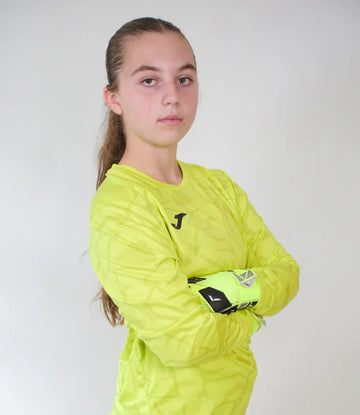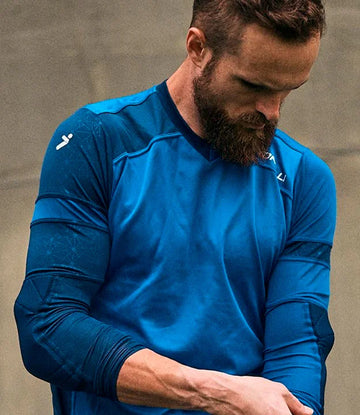During a season, there will be moments within a match when the goalkeeper will be called upon to make the special save. The save will be recorded on the score sheet like any other shot attempt. But to the seasoned professionals, the importance of this save could be the difference between winning and losing, as well as promotion and relegation. The spectacular save not only changes the complexity of the match, but it re-energizes a team and awakens their fighting spirit. Spectators may view this save as “unexpected,” but to the goalkeeper who puts countless hours of training into a week this save is the result of hard work and commitment to their craft.
Through our numerous years of training goalkeepers at SoccerPlus Goalkeeper School, we have come to believe that a goalkeeper’s ability to dive is truly special. Every aspiring goalkeeper who attends the camp has the intention of making that extraordinary diving save, but not every goalkeeper has the athletic ability to fully propel themselves through the air and catch the ball. In addressing this topic of “Advanced Catching and Diving,” the following three saves will be covered: 1. Extension Diving, 2. Parrying, and 3. Tipping Back to the Bar. Furthermore, the article will identify the physical, technical, tactical and psychological implications needed to make these types of saves.
The Diving Saves
Extension Diving: There are two types of diving saves. The more elementary version identified in article 1 is called the Collapse Dive. A collapse dive is when the keeper catches the ball before diving. The other type of dive and the type we are identifying and training is Extension Diving or diving first and catching while flying towards the ball.
This is an explosive save used to cope with shots struck initially outside the reach of the goalkeeper. Using quick footwork, the goalkeeper propels the body through the air and catches the ball in mid-flight. Unlike the collapse dive, the feet are airborne.
Parrying: Deriving from the extension dive; the goalkeeper utilizes one or two hands to redirect the flight of the ball outside the goal. Balls that cannot be caught can be redirected using the fingertips or the heel-of-the-hand.
Tipping Back to the Bar: While using proper footwork to get back to the goal line and having precise timing, the goalkeeper extends up into the air to redirect the ball over the top of the crossbar.
The Four Pillars
Like other players, to examine the goalkeeper’s capabilities to make the dynamic diving save, I will use the “Four Pillars”, which are commonly known as the physical, technical, tactical, and psychological components of the game. Assessment and evaluation of the goalkeeper using the four pillars allows coaches to pinpoint areas of concern, as well as track the amount of progress made in their development. Obviously, higher level goalkeepers possess extraordinary abilities in reference to the four components. In preparation to making these types of saves, goalkeepers must consider the following implications:
Physical
- Height – will determine starting position. Smaller goalkeepers will stand closer to the goal line; taller will stand further off the goal line.
- Power (explosiveness) – 1) main attribute used to dive for balls struck outside the comfort zone, 2) vertical jump.
- Strength – assists with propelling body off the ground, as well as absorbing contact with ground.
- Agility – the goalkeeper’s ability to change direction (up/down, side to side, forward/backward).
- Foot Speed – main ingredient used to make these saves; sprint, shuffle, cross-over step, and drop-step.
- Reaction Speed – quick reflexes.
- Flexibility – being limber.
Technical
- Extension Dive – take forward step with the foot closest to the ball. Place weight on that leg as you bend. Using your arms and opposite leg, transfer momentum and drive your body towards the ball. Upon catching the ball, continue to drive through the ball while descending towards the ground. The ball should be the first thing to hit the ground, being used to absorb impact while also using the ground to help secure the catch.
- Parrying – progression is the same as the extension dive. Being fully extended in the air, the goalkeeper can use two different surfaces of hand to redirect uncatchable shots. 1) Fingertip: used for shots hit soft enough to be redirected around or over the goal. 2) Heel-of-the Hand: used for shots hit too hard to be caught or redirected with the fingers. The heel is the part of the hand at the bottom of the palm, just above the wrist. Use of the heel of the hand will allow the goalkeeper to deflect hard shots with force far away from danger. Avoid trying to slap or stop the ball; make the decision to catch or parry.
- Tipping (Back to the Bar) – goalkeeper starts in a sprinter stance. They immediately drop-step and move into a crossover step after reading the flight of the ball towards the goal. At the last moment, they leap off the back foot and drive the closest hand up to the ball. Contact with the ball is made with strong fingertips, using a subtle jab through the center of the ball.
Tactical
- Assess the distance and position of the ball to determine vertical and lateral positioning.
- Assess whether there is pressure on the ball and which foot the ball is being struck with on goal.
- Recognize that if the ball is bouncing, the goalkeeper’s position should be closer to the goal line.
- Recognize the approach of the shooter. Usually, a strong/faster approach towards the ball indicates a shot with power; if the shooter slows down, it represents a possible chip.
- Weather Conditions – should influence the goalkeeper’s decision to catch, box or parry.
- Anticipation – the goalkeeper who reads the game well and anticipates the next touch (pass, dribble or shot) generally arrives in the proper position to make the play sooner.
Psychological
- Confidence – goalkeepers must believe that they can make the spectacular save.
- Concentration – maintaining focus throughout the match; including stoppage time/overtime. Knowing that at any given moment, they may be called upon to make the special save.
- Composure – be relaxed under pressure; embrace the moment.
- Courage – this is the biggest hurdle for youth goalkeepers. When learning and training these types of saves, most fear hurting themselves. Also, many youth goalkeepers favor diving to one particular side; they need to address these “mental blocks.”
- Training Ethics/Motivation – success is equated with preparation. To achieve and maintain a high level of goalkeeping, you commit yourself to training. Incredible saves should only surprise those who are unprepared to make them.
Without question, saves of this magnitude reverberate for years. To this day, people refer to Gordan Banks’ save on Pele’ during the 1970 World Cup as the greatest save ever made. In the women’s game, the diving save by Brianna Scurry on a penalty kick during the 1996 Olympic Finals set the stage for Brandi Chastain’s winning goal. On the biggest stages, such as the World Cup and Olympic Games, world class goalkeepers will emerge with world class saves. It is this intangible quality that separates them from other players.
George Kostelis is the owner and director of GK Soccer Training and the National Director of the SoccerPlus Goalkeeper School.






 Gloves
Gloves
 Jerseys
Jerseys
 Gear
Gear
 Brands
Brands
